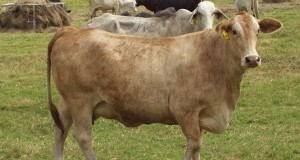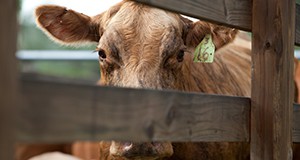 Shrink in beef cattle is weight loss that occurs between an animal’s departure from one location and weigh-in at another. Shrink in beef calves constitutes a potential economic loss to both the seller and the buyer if it is not fully considered. This 3-page fact sheet discusses factors that affect shrink and the effects of shrink on calf price. Written by Matt Hersom, Todd Thrift, and Joel Yelich, and published by the UF Department of Animal Sciences, December 2015.
Shrink in beef cattle is weight loss that occurs between an animal’s departure from one location and weigh-in at another. Shrink in beef calves constitutes a potential economic loss to both the seller and the buyer if it is not fully considered. This 3-page fact sheet discusses factors that affect shrink and the effects of shrink on calf price. Written by Matt Hersom, Todd Thrift, and Joel Yelich, and published by the UF Department of Animal Sciences, December 2015.
http://edis.ifas.ufl.edu/an322
Tag: Animal Sciences Department
Estrous Synchronization and Fixed-Time Artificial Insemination
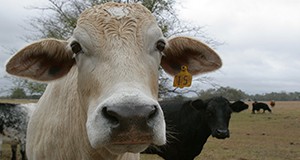 The economic success of beef cow-calf operations depends on the production of one healthy calf per cow per year. To achieve this goal, cow-calf producers need to overcome several obstacles related to the cow, bull, and offspring. Over the last four decades, several advances in reproductive biotechnologies, such as artificial insemination (AI), synchronization of estrus, and fixed-time AI (TAI), have allowed producers to improve the genetic traits of their cattle and shorten the lengths of both the breeding season and subsequent calving season, which can lead to increased overall profitability of cow-calf production systems. This 5-page fact sheet discusses benefits of synchronization and TAI use, obstacles that hinder adoption of reproductive biotechnologies, objectives of the Beef Reproduction Task Force, and factors that can affect the success of TAI programs. Written by Vitor R. G. Mercadante, Darren D. Henry, Francine M. Ciriaco, Pedro L. P. Fontes, Nicky Oosthuizen, and G. Cliff Lamb, and published by the UF Department of Animal Sciences, January 2016.
The economic success of beef cow-calf operations depends on the production of one healthy calf per cow per year. To achieve this goal, cow-calf producers need to overcome several obstacles related to the cow, bull, and offspring. Over the last four decades, several advances in reproductive biotechnologies, such as artificial insemination (AI), synchronization of estrus, and fixed-time AI (TAI), have allowed producers to improve the genetic traits of their cattle and shorten the lengths of both the breeding season and subsequent calving season, which can lead to increased overall profitability of cow-calf production systems. This 5-page fact sheet discusses benefits of synchronization and TAI use, obstacles that hinder adoption of reproductive biotechnologies, objectives of the Beef Reproduction Task Force, and factors that can affect the success of TAI programs. Written by Vitor R. G. Mercadante, Darren D. Henry, Francine M. Ciriaco, Pedro L. P. Fontes, Nicky Oosthuizen, and G. Cliff Lamb, and published by the UF Department of Animal Sciences, January 2016.
http://edis.ifas.ufl.edu/an324
The Economic Impact of Feed Efficiency in Beef Cattle
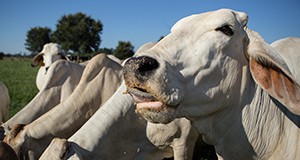 A well-run, profitable business is usually more efficient than its competitors. In the case of the beef cattle industry, competition can come from two sources: other producers who sell similar classes of cattle, and other protein-producing species, such as pork and poultry. Measuring efficiency across the entire integrated beef system can be difficult due to the differing classes of cattle, breed differences, and ways in which the biological systems interact. There are a multitude of measures of efficiency in beef production, with feed efficiency being one of the most economic. This 3-page fact sheet is a major revision that covers feed to gain ratio and residual feed intake in beef cattle. Written by Travis D. Maddock, Darren D. Henry, and G. Cliff Lamb, and published by the UF Department of Animal Sciences. Original publication date: May 2009. Revised October 2015.
A well-run, profitable business is usually more efficient than its competitors. In the case of the beef cattle industry, competition can come from two sources: other producers who sell similar classes of cattle, and other protein-producing species, such as pork and poultry. Measuring efficiency across the entire integrated beef system can be difficult due to the differing classes of cattle, breed differences, and ways in which the biological systems interact. There are a multitude of measures of efficiency in beef production, with feed efficiency being one of the most economic. This 3-page fact sheet is a major revision that covers feed to gain ratio and residual feed intake in beef cattle. Written by Travis D. Maddock, Darren D. Henry, and G. Cliff Lamb, and published by the UF Department of Animal Sciences. Original publication date: May 2009. Revised October 2015.
http://edis.ifas.ufl.edu/an217
Risk Management for 4-H Youth Development Work: Large Animals: Livestock
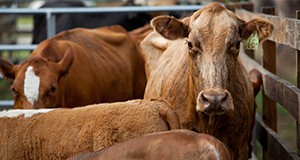 Most people involved in youth livestock exhibition are familiar with the physical risks of handling and transporting livestock, but public spectators generally need more instruction and supervision to ensure their safety and health. The Risk Management for 4-H Youth Development Work series aims to provide UF/IFAS Extension county faculty, staff, volunteers, and youth with the knowledge they need to implement best practices in risk management strategies. This 8-page fact sheet covers risks in the following categories: injuries to people, injuries to animals, property damage, biosecurity (diseases transmitted to humans and between animals), and general precautions. Written by Chad Carr, Saundra TenBroeck, Wendy DeVito, Chris Strong, Dale Pracht, and Georgene Bender, and published by the UF Department of Animal Sciences, November 2015.
Most people involved in youth livestock exhibition are familiar with the physical risks of handling and transporting livestock, but public spectators generally need more instruction and supervision to ensure their safety and health. The Risk Management for 4-H Youth Development Work series aims to provide UF/IFAS Extension county faculty, staff, volunteers, and youth with the knowledge they need to implement best practices in risk management strategies. This 8-page fact sheet covers risks in the following categories: injuries to people, injuries to animals, property damage, biosecurity (diseases transmitted to humans and between animals), and general precautions. Written by Chad Carr, Saundra TenBroeck, Wendy DeVito, Chris Strong, Dale Pracht, and Georgene Bender, and published by the UF Department of Animal Sciences, November 2015.
http://edis.ifas.ufl.edu/an321
Sous Vide Cookery: Foodservice Application for Larger, Less Tender Cuts
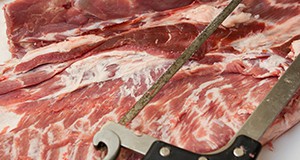 Meat with an abundance of connective tissue presents a certain challenge to cooks who want to make it more tender while still properly eliminating pathogens that cause foodborne illness. Sous vide cookery provides precise temperature control and tenderness improvement with minimal supervision throughout cooking as well as consistent, almost perfect reproducibility. This 4-page fact sheet introduces the reader to the sous vide method and covers its advantages and necessary equipment. The piece also offers tips on cooking, chilling, storing, and reheating large cuts of meat. Written by Chad Carr, Derek Griffing, Kaylie Madore, Dwain Johnson, Jason Scheffler, and João Neto, and published by the UF Department of Animal Sciences, September 2015.
Meat with an abundance of connective tissue presents a certain challenge to cooks who want to make it more tender while still properly eliminating pathogens that cause foodborne illness. Sous vide cookery provides precise temperature control and tenderness improvement with minimal supervision throughout cooking as well as consistent, almost perfect reproducibility. This 4-page fact sheet introduces the reader to the sous vide method and covers its advantages and necessary equipment. The piece also offers tips on cooking, chilling, storing, and reheating large cuts of meat. Written by Chad Carr, Derek Griffing, Kaylie Madore, Dwain Johnson, Jason Scheffler, and João Neto, and published by the UF Department of Animal Sciences, September 2015.
http://edis.ifas.ufl.edu/an320
Avian Diseases Transmissible to Humans
 Anyone who keeps birds, whether as pets or as production animals, should be aware that certain avian diseases can be transmitted to humans. The seriousness of the disease in humans varies with human hosts’ age, overall health, and immune status as well as virulence of the organism, infective dose, and route of infection. This 4-page fact sheet is a major revision which discusses causes and symptoms of avian influenza (bird flu), chlamydiosis, salmonellosis, colibacillosis, encephalitis viruses, avian tuberculosis, Newcastle Disease, and cryptosporidiosis. Written by Michael A. Davis, Gary D. Butcher, and F. Ben Mather, and published by the UF Department of Animal Sciences, revised August 2015. Original publication date: August 1997.
Anyone who keeps birds, whether as pets or as production animals, should be aware that certain avian diseases can be transmitted to humans. The seriousness of the disease in humans varies with human hosts’ age, overall health, and immune status as well as virulence of the organism, infective dose, and route of infection. This 4-page fact sheet is a major revision which discusses causes and symptoms of avian influenza (bird flu), chlamydiosis, salmonellosis, colibacillosis, encephalitis viruses, avian tuberculosis, Newcastle Disease, and cryptosporidiosis. Written by Michael A. Davis, Gary D. Butcher, and F. Ben Mather, and published by the UF Department of Animal Sciences, revised August 2015. Original publication date: August 1997.
http://edis.ifas.ufl.edu/ps019
Small Flock Poultry Nutrition
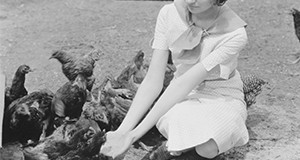
Inadequate poultry nutrition results in substandard growth rates as well as decreased egg production and weight. In order to express the genetic potential for which they were selected, meat- and egg-type birds must receive the correct amounts of nutrients and energy through properly formulated rations. This 4-page fact sheet examines the roles of water, carbohydrates, proteins and amino acids, lipids (fats and oils), vitamins, minerals, and feed additives in poultry growth and development. It also emphasizes the importance of providing suitable feeds to birds of different ages and discusses common feeding mistakes. Written by Michael A. Davis, published by the UF Department of Animal Sciences, and reviewed and revised August 2015. This fact sheet is a major revision of “Small Poultry Flock Nutrition,” written by B. L. Damron and D. R. Sloan, April 1998.
http://edis.ifas.ufl.edu/ps033
Implications of Cow Body Condition Score on Productivity
Body condition score (BCS) indicates how much fat a cow has on its body, which is an important factor in cow health and reproductive capacity. Growers can use BCS to understand and manage the health of a herd and maintain a profitable operation. This 6-page fact sheet explains how BCS is measured, what different scores mean, the economic impact of various scores, and how changing cow nutrition can move BCS in a desired direction. Written by Matt Hersom, Todd Thrift, and Joel Yelich, and published by the UF Department of Animal Sciences, September 2015.
http://edis.ifas.ufl.edu/an319
Implants for Cow-Calf and Stocker Beef Cattle
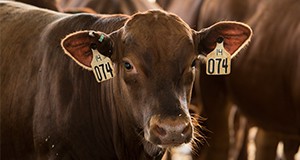
Getting cattle to put on a lot of muscle quickly is a crucial part of a beef cattle operation’s profitability. Growth promoting implants are one of the most cost-effective ways of increasing lean tissue in cattle and work by releasing hormones into the cow’s body that encourage muscle growth. This 4-page fact sheet explains implants’ mechanisms of action, how implants are administered and used, and concerns associated with implants. Written by Matt Hersom and Todd Thrift, and published by the UF Department of Animal Sciences, August 2015.
http://edis.ifas.ufl.edu/an318
Improving the Productivity of Beef Heifers in Florida
 Beef replacement heifers are a necessary but costly part of every cow-calf operation. A decision needs to be made to either purchase replacement heifers or raise them on the ranch. This is a long-term decision that will affect the ranch for many years through the genetics of the replacement heifers and through equipment and management inputs. This 9-page fact sheet provides an analysis of considerations for raising replacements; factors to consider in selection; and recommendations for nutritional management. Written by Phillip Lancaster, Chris Prevatt, and John Arthington, and published by the UF Department of Animal Sciences, March 2015. (Photo: Beef Improvement Federation)
Beef replacement heifers are a necessary but costly part of every cow-calf operation. A decision needs to be made to either purchase replacement heifers or raise them on the ranch. This is a long-term decision that will affect the ranch for many years through the genetics of the replacement heifers and through equipment and management inputs. This 9-page fact sheet provides an analysis of considerations for raising replacements; factors to consider in selection; and recommendations for nutritional management. Written by Phillip Lancaster, Chris Prevatt, and John Arthington, and published by the UF Department of Animal Sciences, March 2015. (Photo: Beef Improvement Federation)
http://edis.ifas.ufl.edu/an132
How Do I Legally Sell Meat from Alligators, Wild Game, or My Farmed Game or Birds in Florida?
 Game meats provide wholesome and nutritious animal protein, but learning the regulations (and which agency has jurisdiction over which regulations) can be burdensome for those who want to be entrepreneurial. This 4-page fact sheet is a “one-stop-shop” for Florida residents who want to sell products from alligators, wild game, or their own farmed game or birds. Written by Chad Carr, Jason Scheffler, Larry Eubanks, Ron Webb, Lee Cornman, Scotland Talley, and Steve Stiegler, and published by the UF Department of Animal Sciences, December 2014. (Photo: iStock/Thinkstock.com)
Game meats provide wholesome and nutritious animal protein, but learning the regulations (and which agency has jurisdiction over which regulations) can be burdensome for those who want to be entrepreneurial. This 4-page fact sheet is a “one-stop-shop” for Florida residents who want to sell products from alligators, wild game, or their own farmed game or birds. Written by Chad Carr, Jason Scheffler, Larry Eubanks, Ron Webb, Lee Cornman, Scotland Talley, and Steve Stiegler, and published by the UF Department of Animal Sciences, December 2014. (Photo: iStock/Thinkstock.com)
http://edis.ifas.ufl.edu/an315
How Do I Legally Sell Meat from My Own Livestock and Poultry in Florida?
 There is much interest in locally produced foods, but the federal, state, and local regulations can be confusing. This 5-page fact sheet is a “one-stop-shop” for Florida residents who want to sell meat from their own livestock and poultry. Written by Chad Carr, Jason Scheffler, Larry Eubanks, Ron Webb, Lee Cornman, Scotland Talley, and Steve Stiegler, and published by the UF Department of Animal Sciences, December 2014. (Photo: iStock/Thinkstock.com)
There is much interest in locally produced foods, but the federal, state, and local regulations can be confusing. This 5-page fact sheet is a “one-stop-shop” for Florida residents who want to sell meat from their own livestock and poultry. Written by Chad Carr, Jason Scheffler, Larry Eubanks, Ron Webb, Lee Cornman, Scotland Talley, and Steve Stiegler, and published by the UF Department of Animal Sciences, December 2014. (Photo: iStock/Thinkstock.com)
http://edis.ifas.ufl.edu/an316
Selective Antibiotic Treatment for Dairy Cow Mastitis
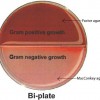 Mastitis is the most common disease in dairy cattle and is estimated to cost dairy farmers $179 a case. When farmers detect clinical mastitis, they usually take immediate action with antibiotics; but many cases either do not need antimicrobial treatment, resolve without treatment, or are not effectively treated by the antimicrobial used. A selective treatment approach can be more effective. This two-step strategy involves first identifying the pathogen, then deciding on a treatment — this would decrease the use of antimicrobials as well as treatment-associated costs for the farmer. This 5-page fact sheet was written by Kathryn Merriman, Fiona Maunsell, Corwin Nelson, and Albert De Vries, and published by the UF Department of Animal Sciences, December 2014. (Photo: University of Minnesota Laboratory for Udder Health, 2004)
Mastitis is the most common disease in dairy cattle and is estimated to cost dairy farmers $179 a case. When farmers detect clinical mastitis, they usually take immediate action with antibiotics; but many cases either do not need antimicrobial treatment, resolve without treatment, or are not effectively treated by the antimicrobial used. A selective treatment approach can be more effective. This two-step strategy involves first identifying the pathogen, then deciding on a treatment — this would decrease the use of antimicrobials as well as treatment-associated costs for the farmer. This 5-page fact sheet was written by Kathryn Merriman, Fiona Maunsell, Corwin Nelson, and Albert De Vries, and published by the UF Department of Animal Sciences, December 2014. (Photo: University of Minnesota Laboratory for Udder Health, 2004)
http://edis.ifas.ufl.edu/an306
Environmental Impact of Beef Cattle Production Systems
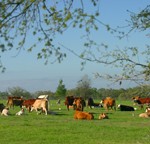 This 6-page fact sheet discusses beef demand in the context of a growing population, beef production’s greenhouse gases and their effect on the environment, the great advantage of ruminants, generating accurate greenhouse gas emissions estimates, greenhouse gas emissions by economic sector, and mitigation strategies. Written by Nicolas DiLorenzo, G. Cliff Lamb, Jose Dubeux, John Arthington, Joao Vendramini, and Phillip Lancaster and published by the UF/IFAS Department of Animal Sciences, November 2014. (UF/IFAS Photo by Thomas Wright)
This 6-page fact sheet discusses beef demand in the context of a growing population, beef production’s greenhouse gases and their effect on the environment, the great advantage of ruminants, generating accurate greenhouse gas emissions estimates, greenhouse gas emissions by economic sector, and mitigation strategies. Written by Nicolas DiLorenzo, G. Cliff Lamb, Jose Dubeux, John Arthington, Joao Vendramini, and Phillip Lancaster and published by the UF/IFAS Department of Animal Sciences, November 2014. (UF/IFAS Photo by Thomas Wright)
http://edis.ifas.ufl.edu/an302
Potential Bull Buyers Perceive Increased Value to their Operations When Purchasing Bulls from the Florida Bull Test
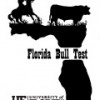 Since its beginning in 2000, the Florida Bull Test has been under constant evolution to achieve its goal of helping producers select high-quality sires, thereby improving production and profitability of beef cattle producers in Florida and the Southeast United States. A survey of potential buyers before the 2014 sale succeeded in identifying which characteristics of bulls are most important to buyers purchasing bulls: purchasing bulls from the Florida Bull Test increases the value of calves sired by improving performance, genetics, and feed efficiency of their herds. This 3-page fact sheet was written by Vitor R. G. Mercadante, Darren D. Henry, Francine M. Ciriaco, Paula M. Mercadante, Tessa Schulmeister, Nicolas DiLorenzo, and G. Cliff Lamb, and published by the UF Department of Animal Sciences, November 2014.
Since its beginning in 2000, the Florida Bull Test has been under constant evolution to achieve its goal of helping producers select high-quality sires, thereby improving production and profitability of beef cattle producers in Florida and the Southeast United States. A survey of potential buyers before the 2014 sale succeeded in identifying which characteristics of bulls are most important to buyers purchasing bulls: purchasing bulls from the Florida Bull Test increases the value of calves sired by improving performance, genetics, and feed efficiency of their herds. This 3-page fact sheet was written by Vitor R. G. Mercadante, Darren D. Henry, Francine M. Ciriaco, Paula M. Mercadante, Tessa Schulmeister, Nicolas DiLorenzo, and G. Cliff Lamb, and published by the UF Department of Animal Sciences, November 2014.
http://edis.ifas.ufl.edu/an313
Understanding Pregnancy Diagnosis in Beef Cattle
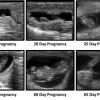 Because 55 to 70 percent of the input costs associated with a beef cattle operation are related to nutrition, culling open (non-pregnant) cows after the breeding season can save as much as $200 per head that can be diverted to the purchase or development of replacement females, sire selection, increased nutritional management, and other management-related costs. Pregnancy diagnosis can be performed simply during vaccination or at the time of weaning. There are three practical methods: rectal palpation, transrectal ultrasonography, or blood test. This 5-page fact sheet was written by G. Cliff Lamb, Darren D. Henry, Vitor R. G. Mercadante, and Doug E. Mayo, and published by the UF Department of Animal Sciences, November 2014.
Because 55 to 70 percent of the input costs associated with a beef cattle operation are related to nutrition, culling open (non-pregnant) cows after the breeding season can save as much as $200 per head that can be diverted to the purchase or development of replacement females, sire selection, increased nutritional management, and other management-related costs. Pregnancy diagnosis can be performed simply during vaccination or at the time of weaning. There are three practical methods: rectal palpation, transrectal ultrasonography, or blood test. This 5-page fact sheet was written by G. Cliff Lamb, Darren D. Henry, Vitor R. G. Mercadante, and Doug E. Mayo, and published by the UF Department of Animal Sciences, November 2014.
http://edis.ifas.ufl.edu/an314
Saddle and Tack Care in Hot and Humid Environments
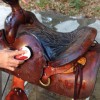 The South’s climate is appealing for equestrian activities. While riders enjoy the weather, it creates some challenges in caring for saddles and other tack. When the weather becomes hot and the humidity climbs and the rains are frequent, a tack room can become a breeding ground for mold and mildew. There are several things a rider can do, however, to lower the incidence of mildew on saddles and tack. This 3-page fact sheet was written by Joel McQuagge, Todd Thrift, and Ed Johnson, and published by the UF Department of Animal Sciences, November 2014. (Photo credit: Joel McQuagge, UF/IFAS)
The South’s climate is appealing for equestrian activities. While riders enjoy the weather, it creates some challenges in caring for saddles and other tack. When the weather becomes hot and the humidity climbs and the rains are frequent, a tack room can become a breeding ground for mold and mildew. There are several things a rider can do, however, to lower the incidence of mildew on saddles and tack. This 3-page fact sheet was written by Joel McQuagge, Todd Thrift, and Ed Johnson, and published by the UF Department of Animal Sciences, November 2014. (Photo credit: Joel McQuagge, UF/IFAS)
http://edis.ifas.ufl.edu/an303
Targeting ADG of Developing Replacement Heifers Using Age and Body Weight
 Heifer development continues to be one of the largest expenses to cow-calf operations, primarily due to cost of feed. Replacement heifers should be bred to calve at 24 months of age in order to maximize lifetime productivity of breeding females. Therefore, heifers should conceive at 15 months of age and achieve puberty at 13–14 months of age because heifers are infertile on the pubertal estrous cycle. This 4-page fact sheet was written by Phillip Lancaster and Cliff Lamb, and published by the UF Department of Animal Sciences, September 2014.
Heifer development continues to be one of the largest expenses to cow-calf operations, primarily due to cost of feed. Replacement heifers should be bred to calve at 24 months of age in order to maximize lifetime productivity of breeding females. Therefore, heifers should conceive at 15 months of age and achieve puberty at 13–14 months of age because heifers are infertile on the pubertal estrous cycle. This 4-page fact sheet was written by Phillip Lancaster and Cliff Lamb, and published by the UF Department of Animal Sciences, September 2014.
http://edis.ifas.ufl.edu/an305
Cow Math: Using Weaning Weight to Estimate Cowherd Productivity
 “You can’t get where you’re going unless you know where you are.”
“You can’t get where you’re going unless you know where you are.”
The ability to measure performance is a key component in all beef cow operations, and measuring production efficiency is becoming increasingly important. Regardless of size, producers must be able to identify the current status of their operation in order to make adjustments toward improvement. Identifying and culling the cows within the herd that are less efficient at producing a weaned calf in the environment and management system used on the ranch can be a powerful tool to improve the herd. This 8-page fact sheet was written by Phillip Lancaster and John Arthington, and published by the UF Department of Animal Science, April 2014.
http://edis.ifas.ufl.edu/an129
The Florida Bull Test, 2013-2014
 The 2013-2014 Florida Bull Test was a 112-day performance test and a breeding soundness evaluation of each bull that qualified for the auction. Table 1 summarizes feed efficiency data; Table 2 individual feed intake and feed efficiency; and Table 3 individual animal performance. This 10-page fact sheet was written by Vitor R. G. Mercadante, G. Cliff Lamb, and Nicolas DiLorenzo, and published by the UF Department of Animal Sciences, May 2014.
The 2013-2014 Florida Bull Test was a 112-day performance test and a breeding soundness evaluation of each bull that qualified for the auction. Table 1 summarizes feed efficiency data; Table 2 individual feed intake and feed efficiency; and Table 3 individual animal performance. This 10-page fact sheet was written by Vitor R. G. Mercadante, G. Cliff Lamb, and Nicolas DiLorenzo, and published by the UF Department of Animal Sciences, May 2014.
http://edis.ifas.ufl.edu/an301
